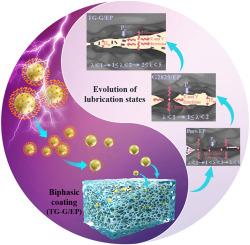一种新型复合油微滴增强双相环氧涂层,具有超低摩擦磨损性能
IF 11.6
2区 材料科学
Q1 CHEMISTRY, PHYSICAL
引用次数: 0
摘要
基于固体填料固有特性的自润滑涂层经常遇到许多挑战。合理设计具有超低摩擦和高界面相容性的油固双相涂层是可行的解决方案。通过胶束加载-解吸方法,将油性氧化石墨烯微滴均匀分散在环氧树脂中,形成油-固两相涂层。确定并分析了双相涂层独特的界面和摩擦学性能。双相涂层的界面润滑状态更多地受到油微滴粘压效应的影响,而非表面弹性变形的影响。由于改性氧化石墨烯纳米片的引入、润滑状态的诱导转变以及油基润滑膜的形成,双相涂层显著降低了摩擦和磨损,与环氧树脂相比,摩擦系数降低了92.7%,磨损率降低了40.16%。本研究提出的具有优异摩擦学性能的双相涂层在实现工程部件的高效润滑(类似于人体关节)方面具有巨大的前景。本文章由计算机程序翻译,如有差异,请以英文原文为准。

A novel biphasic epoxy coating reinforced with composite oil microdroplets for ultra-low friction and wear
Self-lubricating coatings based on the intrinsic properties of solid fillers often encounter numerous challenges. Rationally designed oil-solid biphasic coatings with ultra-low friction and high interfacial compatibility may offer a feasible solution. Herein, oily graphene oxide microdroplets were uniformly dispersed in epoxy resin via a micelle loading-desorption method, creating an oil-solid biphasic coating. The distinctive interfacial and tribological behavior of the biphasic coating is determined and analyzed. The interfacial lubrication state of the biphasic coating is more influenced by the viscosity–pressure effect of oil microdroplets rather than surface elastic deformation. Due to the introduction of modified graphene oxide nanosheets, the induced transition of the lubrication state, and the formation of an oil-based lubricant film, biphasic coating significantly reduced friction and wear, achieving a 92.7 % reduction in the coefficient of friction and a 40.16 % decrease in the wear rate compared to epoxy resin. The biphasic coating with excellent tribological performance proposed in this work shows huge prospects for achieving efficient lubrication (akin to human joints) in engineering components.
求助全文
通过发布文献求助,成功后即可免费获取论文全文。
去求助
来源期刊

Carbon
工程技术-材料科学:综合
CiteScore
20.80
自引率
7.30%
发文量
0
审稿时长
23 days
期刊介绍:
The journal Carbon is an international multidisciplinary forum for communicating scientific advances in the field of carbon materials. It reports new findings related to the formation, structure, properties, behaviors, and technological applications of carbons. Carbons are a broad class of ordered or disordered solid phases composed primarily of elemental carbon, including but not limited to carbon black, carbon fibers and filaments, carbon nanotubes, diamond and diamond-like carbon, fullerenes, glassy carbon, graphite, graphene, graphene-oxide, porous carbons, pyrolytic carbon, and other sp2 and non-sp2 hybridized carbon systems. Carbon is the companion title to the open access journal Carbon Trends. Relevant application areas for carbon materials include biology and medicine, catalysis, electronic, optoelectronic, spintronic, high-frequency, and photonic devices, energy storage and conversion systems, environmental applications and water treatment, smart materials and systems, and structural and thermal applications.
 求助内容:
求助内容: 应助结果提醒方式:
应助结果提醒方式:


